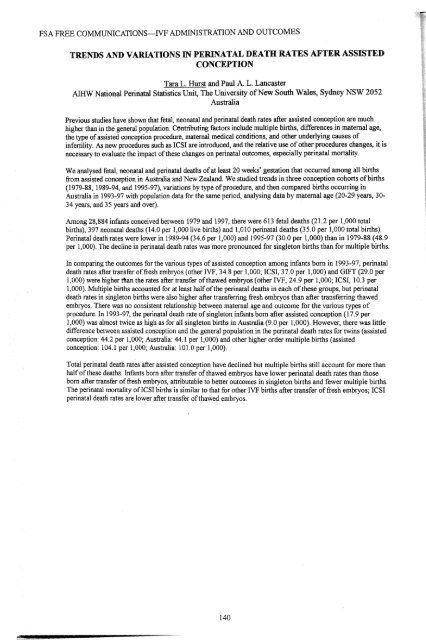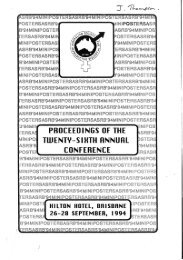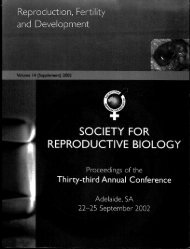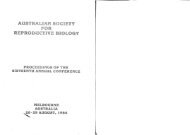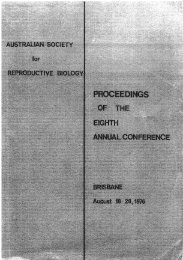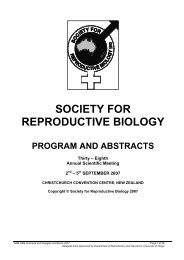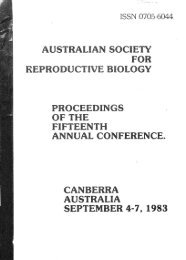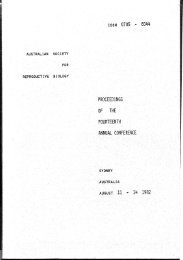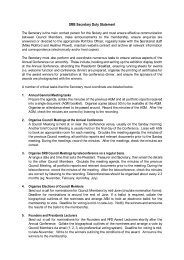ruoounu. nnSlunCIS&UINI-rOSIlnS - the Society for Reproductive ...
ruoounu. nnSlunCIS&UINI-rOSIlnS - the Society for Reproductive ...
ruoounu. nnSlunCIS&UINI-rOSIlnS - the Society for Reproductive ...
Create successful ePaper yourself
Turn your PDF publications into a flip-book with our unique Google optimized e-Paper software.
FSA F~EE COMMUNICATIONS-IVF ADMINISTRATION AND OUTCOMESTRENDS AND VARIATIONS IN PERINATAL DEATH RATES AFTER ASSISTEDCONCEPTIONTara L. Hurst and Paul A. L. LancasterAIHW National Perinatal Statistics Unit, The University ofNew South Wales, Sydney NSW 2052AustraliaP~evious s~dies have shown that fetal, neonatal and perinatal death rates after assisted conception are muchhigher than In !he general population. Contributing factors include multiple births, differences in maternal age,~he typ~ ofassIsted conception procedure, maternal medical conditions, and o<strong>the</strong>r underlying causes oflllfertIhty. As new proced~res such as ICSI are introduc~d, and <strong>the</strong> relative use ofo<strong>the</strong>r procedures changes, it isnecessary to evaluate <strong>the</strong> Impact of<strong>the</strong>se changes on pennatal outcomes, especially perinatal mortality.We anal~sed fetal, ne?nat.al and pe~natal deaths ofat least 20 weeks' gestation that occurred among all birthsfrom aSSIsted conceptIon In AustralIa and New Zealand. We studied trends in three conception cohorts ofbirths(1979-~8,.1989-94, an~ 1995-97),.variations by type ofpr~cedure, and <strong>the</strong>n compared births occurring inAustralIa III 1993-97 WIth populatIOn data <strong>for</strong> <strong>the</strong> same penod, analysing data by maternal age (20-29 years 30-34 years, and 35 years and over). 'A;m0ng 28,884 infants conceived between 1979 and 1997, <strong>the</strong>re were 613 fetal deaths (21.2 per 1,000 totalbIrt~S), 397 neonatal deaths (14.0 per 1,000 live births) and 1,010 perinatal deaths (35.0 per 1,000 total births).Pennatal death rates.we~e 100~er in 1989-94 (34.6 per 1,000) and 1995-97 (30.0 per 1,000) than in 1979-88 (48.9per 1,000). The declIne III pennatal death rates was more pronounced <strong>for</strong> singleton births than <strong>for</strong> multiple births.In comparing <strong>the</strong> outcomes <strong>for</strong> <strong>the</strong> various types ofassisted conception among infants born in 1993-97 perinataldeath rates aft~r transfer offresh embryos (o<strong>the</strong>r IVF, 34.8 per 1,000; ICSI, 37.0 per 1,000) and GIFT (z9.0 per1,000) were ~Ighe: than <strong>the</strong> rates after transfer ofthawed embryos (o<strong>the</strong>r IVF, 24.9 per 1,000; ICSI, 10.3 per1,000). Mu~tIpl.e bIrths a~counted <strong>for</strong> at least halfof<strong>the</strong> perinatal deaths in each of<strong>the</strong>se groups, but perinataldeath rates In smgleton bIrths were also higher after transferring fresh embryos than after transferring thawedembryos. There w~s no consis~ent relationship bet~een mat~mal age and outcome <strong>for</strong> <strong>the</strong> various types ofprocedure. In 199,,-9:, <strong>the</strong> p:nnatal death ~ate ofSIngleton mfants born after assisted conception (17.9 per1:000) was almost twI~e as hIgh as ~or all smgleton births in Australia (9.0 per 1,000). However, <strong>the</strong>re was littledI:fferen~e ~etween aSSIsted concep~IOn and <strong>the</strong> general population in <strong>the</strong> perinatal death rates <strong>for</strong> twins (assistedconcept~on. 44.2 per 1,000; AustralIa: 44.1 per 1,000) and o<strong>the</strong>r higher order multiple births (assistedconceptIOn: 104.1 per 1,000; Australia: 101.0 per 1,000).Total perinatal death rates after assisted conception have declined but multiple births still account <strong>for</strong> more thanhalfof<strong>the</strong>se deaths. Infants born after tr?Jlsfer ofthawed embryos have lower perinatal death rates than thoseborn aft~r transfer o~fresh embry.os, a~n~ut~ble to better outcomes in singleton births and fewer multiple births.Th: pennatal mortalIty ofICSI bIrths IS SImIlar to that <strong>for</strong> o<strong>the</strong>r IVF births after transfer offresh embryos' ICSIpennatal death rates are lower after transfer ofthawed embryos.'FSA FREE COMMUNICATIONS-IVF ADMINISTRATION AND OUTCOMESHEALTH AND DEVELOPMENTAL OUTCOMES OF IVF CHaDREN DURINGTHE FIRST FIVE YEARSG.I. Leslie, C.A. McMahon, 1. Cohen, F. Gibson, C. Tennant, andD.M. Saunders.Nor<strong>the</strong>rn Clinical School, University ofSydney at Royal North Shore Hospital, Pacific Highway, St.Leonards, NSW, AustraliaIntroduction: This paper reports preliminary findings <strong>for</strong> health and child develop~enta~ outcome~ up to ?:eyears from a larger prospective study of health, developmental and psychosocIal adjustment III famIlIesconceiving through IVF.Aim: To compare health and developmental outcomes at one and five years <strong>for</strong> infants conceived using in-vitrofertilisation (IVF).Methods: Primigravid couples were enrolled at 30wk gestation <strong>for</strong> this prospective ~dy o~ parental adjustmentand child health and developmental outcomes of singleton and twin children conceIved usmg IVF. At one andfive years ofage children had a compreh~nsive.physical exa~nation and developm~ntal a~ses~ment and par~ntscompleted a range of psychosocial que~tlOnnatres. At ~~e t~me of assessments detatled hISto~~S were obtamedfrom <strong>the</strong> parents concerning childhood Illnesses and utIlIsatIOn of health care resources. CogmtIve developmentwas assessed using <strong>the</strong> Bayley Scales of Infant Development (second editi~n) at one year and <strong>the</strong> WechslerPreschool and Primary Scale of Intelligence (Revised) at five years. Compansons of outcomes at one and fiveyears were per<strong>for</strong>med using <strong>the</strong> paired t-test.Results: Seventy-one children have been assessed at both one and five years to date. Their mean (ran~~) birthweight was 3106 (1300-4535)g and gestational age was 38.6 (33-42)~k. Mean (range) number of VISItS to ~medical practitioner was significantly less during <strong>the</strong> fifth year than dunng <strong>the</strong> ~~st year [4.~ (0-25) '! ~.3 (~-25),P = 0 000] The difference was due mainly to a decrease in <strong>the</strong> number of VISIts to medIcal specIalIs~S. III <strong>the</strong>latter year~ [0.7 (0-10) v 1.9 (0-6); P = 0.000], although <strong>the</strong>re was also a decrease in <strong>the</strong> number of VISItS to ageneral practitioner [3.5 (0-15) v 5.9 (0-24); P = 0.013].The mean (range) Bayley Mental Development Index (:MDI) at one year was 103 (82-122). At five years <strong>the</strong>mean (range) verbal IQ was lOy (?7-148), th.e per<strong>for</strong>mance IQ was 1~2 (81-~41~ and <strong>the</strong> full scale lQ was lIl r(77-149). The MDI correl.ted Sign'fic.olly WIth both <strong>the</strong> verbal IQ (r - 0.358, P - 0.002) and <strong>the</strong> full scale IQ (= 0.381; P = 0.001), but less so with <strong>the</strong> per<strong>for</strong>mance IQ (r =0.309; P = 0.01).Conclusions: These preliminary data suggest a decreasing utilisation of health care resources ?y IVF ~hildrenafter <strong>the</strong> first year up to <strong>the</strong> age of school entry. Our findings also suggest that most I': chI~dren ~Ill havenormal cognitive development and should <strong>the</strong>re<strong>for</strong>e not be at increased risk <strong>for</strong> learmng dIfficultIes uponcommencing <strong>the</strong>ir schooling.140141


